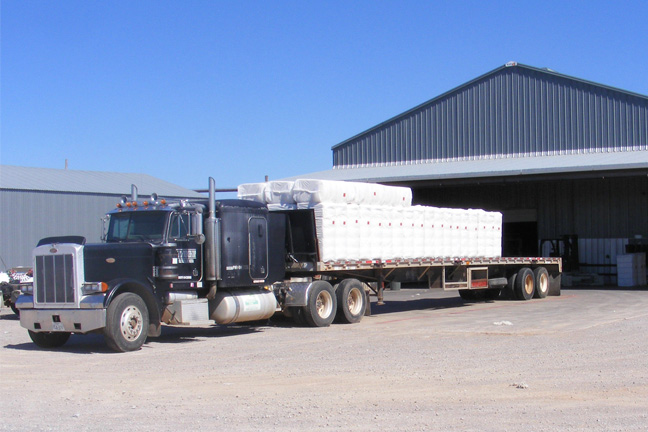
Agricultural News
Drought Wreaks Havoc on Oklahoma Cotton for Second Year
Mon, 17 Dec 2012 10:41:58 CST

Randy Boman and Shane Osborne of the OSU Southwest Oklahoma Research and Extension Center in Altus recap the results of this year's cotton crop in the latest edition of the Cotton Comments Newsletter.
The 2012 crop is definitely winding down. It has been another tough year in the Oklahoma cotton patch. Two years of back-to-back droughts have wreaked havoc in Oklahoma. Interesting graphics courtesy of USDA-RMA concerning crop insurance indemnities paid out by county across the US in 2011 and 2012 are available at the bottom of this story.
Considerable dryland acreage has once again failed. Irrigated yields are essentially a function of how much irrigation capacity was available to the crop, and application efficiency. Some high capacity center pivots and some drip irrigated fields have produced up to 3.5 bales/acre; whereas limited furrow irrigated fields have been closer to one bale/acre.
We are ending 2012 with over 90% of the state in the extreme/exceptional drought categories. Although weather prognosticators in the southern Great Plains are often wrong, they are indicating a continued run of dry conditions.
Based on comments from state climatologists, 2012 may end up being the one of the warmest overall years on record. Cotton heat unit accumulation at Altus was 61, 14, 13, 8, and 14 percent above normal for the months of May, June, July, August and September.
An early freeze/frost event on October 8 in western Oklahoma was a spoiler and likely terminated cotton fiber development in some later maturing fields. However, based on excellent September maturing weather, yield and quality were not devastated as would have occurred during a more normal year.
On October 27, we had a killing freeze over much of the area. Producers were able to get winter wheat and cover crops established on the failed cotton acreage thanks to the late September rainfall (2.3 inches).
The bad news is that October (0.3) and November (0.4) rainfall at Altus produced a rather scant total of 0.7 inches. Normal rainfall for Altus for October (2.7), November (1.5) totals about 4.2 inches. Thus far, December has been pretty much a zero in terms of precipitation. January and February typically deliver about 2 inches. This has huge implications for our winter crops. We are looking forward to getting out of the drought, however, with the fizzling of the El Nino in the Pacific, everyone is looking to the skies
The USDA Crop Production Report released on December 11 indicated that for the US, all cotton production is forecast at 17.3 million 480-pound bales, down 1 percent from last month but up 11 percent from last year. Yield is expected to average 793 pounds per acre, up 3 pounds from last year. Upland cotton production is forecast at 16.6 million 480-pound bales, up 13 percent from 2011.
For Oklahoma in 2012, our planted acreage was about 300,000. USDA-NASS left unchanged from the November Crop Report our harvested acres (175,000), yield per acre (411 lb) and production (150,000 bales). Based on an informal survey of the 17 gins across the state, the total production found was about 100,000 bales. The harvested acreage numbers may be high, the yield per acre should be higher, and the total production should be lower. With respect to these types of statistics, I have been wrong before and will be wrong again.
The fiber quality resilience of the new cotton varieties is amazing. As of December 7, the Abilene, TX, USDA-AMS Classing Office had classed about 81,000 bales from Oklahoma. Color grades are still hanging in there with about 73% classing as an 11, 21 or 31 color (51% 11 or 21, about 22% 31). The early freeze affected some fields, and we currently have about 21% classed as a 12, 22, or 32 color. Leaf grades have been fairly good for this crop, with about 86% classing as a leaf grade 1, 2, or 3. Bark contamination has been about 21%, which is not bad considering the late September rainfall, the early October freeze and stripper harvesting of most acres. A total of 61% of the bales had a 35/32nds or longer staple, with about 36.5% classed with 36 or longer.
Uniformity is averaging 79.9%, but considering the year, and again, stripper harvesting of most acres, it's not too bad. Just over 9% has been classed as low micronaire (less than 3.5), with another 5% in the high micronaire category (greater than 4.9). These low micronaire bales likely reflect the early frost/freeze hit on maturity in some later planted fields. The overwhelming majority of the bales (about 86%) are in the 3.5 to 4.9 range. Strength values are holding up very well, with the average running about 30.2 g/tex, with over 64% above 30 g/tex. Incidentally, the Oklahoma bales classed at Abilene thus far have the highest average staple and strength values, which is great. The Abilene classing office serves east Texas, a portion of west Texas, Oklahoma, and Kansas.
00440_2011_RMA_Crop_Indemnities.pdf
00442_2012_RMA_Crop_Indemnities.pdf
WebReadyTM Powered by WireReady® NSI
Top Agricultural News
More Headlines...



















